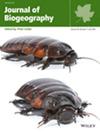The Contemporary Distribution of Scincine Lizards Does Not Reflect Their Biogeographic Origin
Abstract
Aim
We assess the systematic relationships and historical biogeographic patterns in the subfamily Scincinae, a group of lizards that primarily inhabits the Afro-Madagascan and Saharo-Arabian regions with isolated lineages in Europe, North America, East Asia, India and Sri Lanka. The contemporary distribution of these lineages on the historical Laurasian and Gondwanan landmasses make scincines an ideal system to study the roles of vicariance and dispersal on a geologic scale of tens of millions of years.
Location
Global.
Taxon
Subfamily Scincinae (Family Scincidae).
Methods
We conducted biogeographic analyses on a reconstructed, time-calibrated species tree of scincine genera, including members of the other Scincidae subfamilies, using seven nuclear loci (~6 k base pairs). We also constructed a lineage-through-time plot to assess the timing of diversification within scincines.
Results
Our analysis estimated strong support for the monophyly of Scincinae that is further comprised a strongly-supported Gondwanan clade nested within a broader Laurasian group. While most of the extant, genus-level diversity within the Gondwanan clade was accrued post-Eocene, the majority of the Laurasian lineages diverged during the Palaeocene or earlier, suggesting large-scale extinctions on continents of Laurasian origin. Counterintuitively, scincines from India and Sri Lanka have distinct biogeographical origins despite a long tectonic association between these landmasses, suggesting at least two independent, long-distance, trans-oceanic dispersal events into the subcontinent. Our biogeographic analyses suggest that scincines likely originated in East and Southeast Asia during the late Cretaceous (ca. 70 Ma), and eventually dispersed westwards to Africa and Madagascar, where their greatest current-day species richness occurs.
Main Conclusions
Our study demonstrates the concomitant roles of dispersal and extinction in shaping modern-day assemblages of ancient clades such as scincine lizards. Our range evolution analysis shows that despite the greater diversity observed in the Afro-Madagascan region, the origin of scincines can be traced back to Southeast Asia and East Asia, followed by westward dispersals. These dispersals may have been followed by significant extinctions in tropical East Asia, resulting in relatively lower diversity of scincines in these regions. Notably, our analysis reveals that Sri Lankan and Peninsular Indian scincines have distinct evolutionary origins.


 求助内容:
求助内容: 应助结果提醒方式:
应助结果提醒方式:


